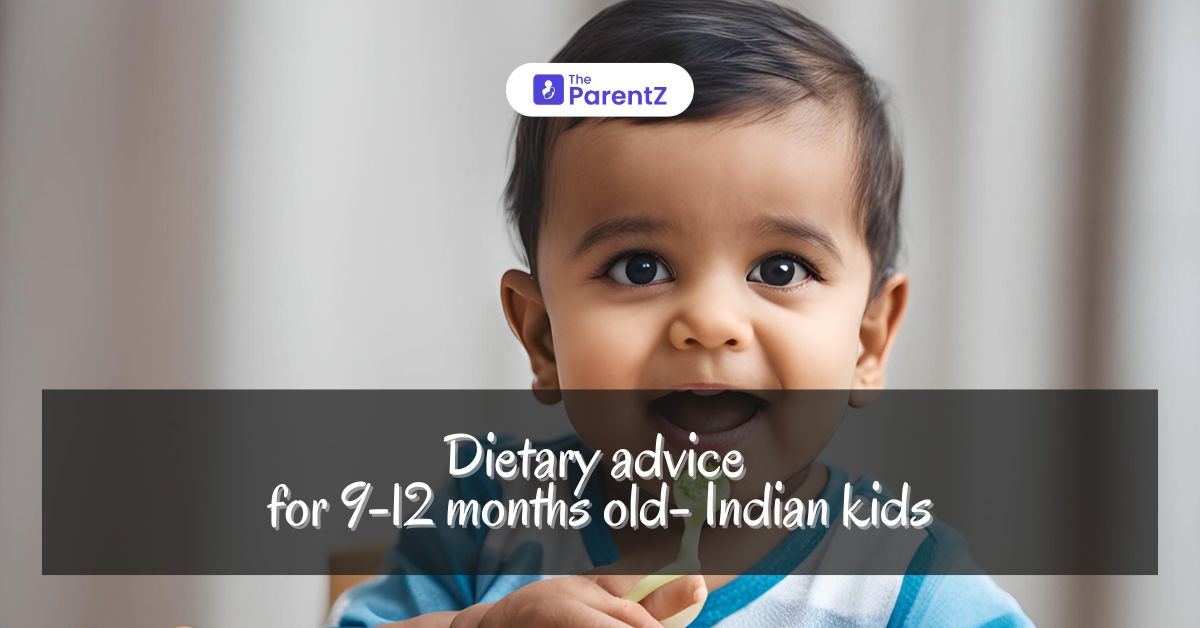The 9 to 12-month period is crucial for an infant’s growth and development. During this time, children transition from primarily breast milk or formula to a more varied diet that includes solid foods.
This article provides comprehensive dietary guidelines for Indian children in this age group based on World Health Organization (WHO) recommendations. These guidelines consider cultural preferences, available foods, and infants’ nutritional needs to ensure optimal growth and development.
Nutritional Needs of 9-12 Month Olds
At 9 to 12 months, children require a balanced diet that includes a variety of nutrients to support rapid growth and brain development. Key nutritional components include:
- Proteins: Essential for growth and repair of tissues. Sources include lentils, dairy, and eggs.
- Carbohydrates: Provide energy for daily activities. Sources include rice, wheat, and fruits.
- Fats: Necessary for brain development and energy. Sources include ghee, butter, and plant oils.
- Vitamins and Minerals are important for overall health. Essential nutrients include iron, calcium, and vitamins A, C, and D.
Breastfeeding and Weaning – Continued Breastfeeding
The WHO recommends continued breastfeeding up to 2 years of age or beyond. Breast milk remains a crucial source of nutrients and antibodies that protect against infections.
Introduction to Solids
By nine months, infants should have already been introduced to solid foods. This period focuses on increasing the variety and texture of foods:
- Gradual Introduction: Start with soft, mashed foods and progress to finely chopped and small pieces of family foods.
- Frequency and Portion Sizes: Offer solid foods 3-4 times a day in addition to breastfeeding. Portion sizes can vary, but a typical serving is 2-3 tablespoons per meal, increasing as the child grows.
Food Groups and Suggested Foods
Cereals and Grains
Cereals and grains are staple foods in the Indian diet. They provide essential carbohydrates and some proteins:
- Rice: Easily digestible and can be served as khichdi or rice porridge.
- Wheat: Can be given as soft chapati or suji (semolina) halwa.
- Millets: Ragi (finger millet) is highly nutritious and can be prepared as porridge.
Pulses and Legumes
Rich in protein and iron, pulses are vital for vegetarian diets:
- Lentils: Masoor dal (red lentils) and moong dal (green gram) can be cooked and mashed.
- Chickpeas: Can be boiled and mashed, often given as part of chana dal.
Fruits and Vegetables
Fruits and vegetables provide vitamins, minerals, and fibre:
- Vegetables: Carrots, potatoes, peas, and spinach should be well-cooked and mashed.
- Fruits: Bananas, apples, pears, and papayas can be mashed or pureed.
Dairy Products
Dairy provides essential calcium and vitamin D. It is recommended that milk is introduced at 12 months of age.
- Curd/Yogurt: Can be given plain or mixed with fruits.
- Paneer: Soft paneer cubes can be offered as finger food.
Animal Foods
For non-vegetarian families, animal foods provide high-quality protein and essential fatty acids:
- Eggs: Well-cooked eggs can be given in various forms, such as boiled or scrambled.
- Chicken and Fish: Small amounts of well-cooked, deboned chicken or fish can be introduced.
Feeding Practices
Texture and Variety
- Texture: Gradually move from pureed to more solid textures. This helps develop chewing skills.
- Variety: Offering a variety of foods helps ensure a balanced intake of nutrients and reduces the risk of food aversions.
Feeding Environment
- Routine: Establish a regular feeding schedule.
- Patience: Allow the child to explore and try foods at their own pace.
- Avoid Force-Feeding: Encourage but do not force the child to eat.
Hygiene and Safety
- Cleanliness: Ensure all feeding utensils are clean.
- Supervision: Always supervise the child during meals to prevent choking.
- Safe Food Preparation: Cook food thoroughly and avoid adding salt or sugar.
Addressing Common Concerns
Food Allergies
Introduce new foods one at a time and watch for signs of allergic reactions, such as rashes, swelling, or digestive issues. Common allergens include cow’s milk, eggs, peanuts, and wheat.
Iron Deficiency
Iron is crucial for cognitive development. Iron-rich foods include lentils, spinach, and fortified cereals. Vitamin C-rich foods, such as oranges and tomatoes, enhance iron absorption.
Hydration
In addition to breast milk or formula, offer small amounts of water in a sippy cup. Avoid sugary drinks and juices.
Picky Eating
It’s normal for toddlers to be fussy eaters. Continue offering a variety of foods without pressuring the child. Repeated exposure often leads to acceptance.
Cultural Considerations
Indian cuisine offers a wealth of nutritious foods suitable for infants:
- Spices: Mild spices like turmeric and cumin can be introduced in small amounts.
- Traditional Foods: Foods like idli, dosa, and upma can be adapted for infants by softening textures and reducing spice levels.
Conclusion
The dietary guidelines for 9 to 12-month-old Indian children emphasize a balanced diet that includes a variety of foods to meet their nutritional needs.
Continued breastfeeding, gradual introduction of solid foods, and maintaining good feeding practices are crucial for optimal growth and development. By incorporating culturally appropriate foods and following the recommendations of WHO and other health organizations, caregivers can ensure that infants receive the best possible nutrition during this critical stage of life.
Ensuring a healthy diet in the first year of life lays the foundation for a lifetime of good health.








Be the first one to comment on this story.